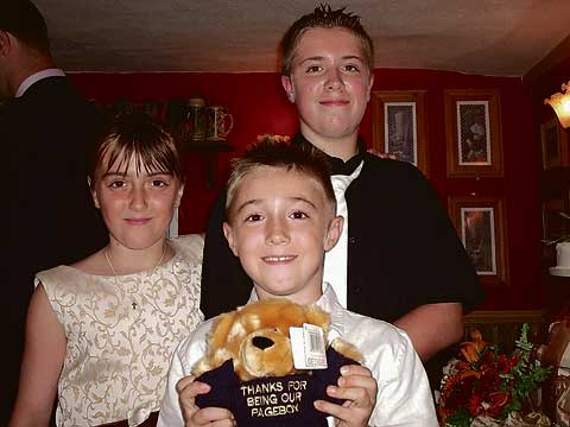FROM a young age Esme knew she wasn’t like other girls. For her birthday she was given a Barbie doll, which was quickly pushed aside and she had never felt like she belonged in the body she was born with, writes Zoë Uglow.
At the age of ten she sat down with her mother and told her that she believe she should be a boy, her mothers reply, “I know”.
From then on Esme began her journey to become the man he is today, Kenzie Randall-Beale.
Kenzie went to visit his local doctors to see what could be done to help him but was told there was nothing they could do until he reached 16 years of age.
Not satisfied with this answer, Kenzie returned to the doctors every year to see if the answer had changed — to his disappointment it was a resounding, no!
At the age of 15, Kenzie and his family moved down from Oxford to Launceston and once they were settled his first stop was obviously the doctors.
By this time, Kenzie had reached 16, an eligible age to go forward with gender realignment and was subsequently referred to The Laurels, a Devon Partnership NHS Trust, which has a specialist Gender Identity Clinic.
However, once referred he was sent a letter informing him that he must be 18 before gender realignment surgery could take place.
He was once again referred, this time to the Tavistock and Portman NHS Foundation Trust, a specialist mental health trust based in north London. Kenzie told the Post: “There [Tavistock and Portman Clinic] I saw a psychiatrist around six times I think, from the age of 17 up until I was 18.
“They then diagnosed me with what is called ‘gender dysphoria’. After ensuring that this was what I wanted, which obviously it was but they have to have confirmation, I went on to the next stage of the process.
“I also saw a psychiatrist at The Laurels from around January to July and was then given hormone injections once I hit 18.
“They basically prescribe you with a form of libido and each injection is 1000mg that needs to be administered every 12 weeks.
“I was told I could do it myself but the needle is huge so I opted to visit my doctor every 12 weeks so they can do it, because I certainly don’t want to!”
In December Kenzie was able, after years of waiting, to begin the gender transformation process — starting with the removal of breast tissue.
He was finally able to have the chest surgery he had been waiting for on April 25, 2014, in Truro.
He was told that he would have to be on the hormone injections for at least a year before they could carry out surgery.
In January 2015, Kenzie was sent for a consultation ahead of his ‘lower surgery’. However, once in consultation doctors raised concerns about Kenzie’s smoking habit.
He was told that he would have to quit before they even considered putting him on the list for surgery, which was yet another hurdle for Kenzie to over come and delayed matters.
Kenzie said: “I then spent the next two months quitting, which was difficult but in the grand scheme of my journey, not the hardest part.
“This was all ahead of a carbon monoxide test doctors carried out in March before allowing me to finally be listed that same month for surgery.”
Kenzie then began the long, and some-what painful, journey of having constructive surgery to create prosthetic genitals. This is one of the final stages of his gender realignment surgery ahead of the insertion of a pump.
The process has left Kenzie with extensive scarring on his left arm as they take a section, including one arterial vein and nerve as part of the phalloplasty.
This has caused Kenzie to lose a substantial amount of feeling in his arm but said that the nerves grow like trees at a rate of 1mm per week so he will regain feeling, just very, very slowly.
One of the biggest changes to Kenzie’s life since surgery has been gaining the ability to urinate whilst standing, he said: “I never thought that after everything I have been through this would effect me mentally, like, all my life I have peed sitting down and it is an unexplainable feeling being able to finally pee standing up.
“It was scary at first and stung, but I remember dancing around the toilet and hearing my gran outside the door asking ‘have we heard a little tinkle yet?’ she has been great through out the whole process and helped take care of me.
Kenzie spoke at length about the support he had received from his family, and how his gran had been an integral part, taking care of him and supporting him through the process, he told the Post: “My Gran is very naughty sometimes, she will say ‘Who is Kenzie?’ to try and wind me up, but as soon as she wants something I am suddenly a ‘good lad’, but I am very lucky because my whole family has been very supportive.”
“It was obviously difficult for my grandparents to come to terms with at first though, like I’m sure it would be for any one, and it took them ages to come round to the idea.
“I was their only grandaughter, being one of three boys at the time before my mum had two more girls.
“I was always my grandparents’ ‘little angel’, nothing I did was wrong. I think it was really in the last three years that they accepted it.”
Kenzie said his mother and father had been supportive all the way through, but his uncle was the one who took it the hardest, he said: “My uncle was about 20 when I was born and we had always been close. We used to go fishing together at the weekends and I was his ‘little dudette’, which makes me cringe now.
“However, he came around, I’d say, in the last couple of years. I remember he took me out into the garden one day and asked me if this was truly what I wanted and when I explained how important this was to me he accepted it there and then and said ‘I am 100% behind you’.”
Kenzie has had his story told before in a double page spread of Closer magazine.
His hope is in the future to go onto television in order to help spread his story to try and help those who are affected by gender dysphoria, showing them what can be achieved and hopefully encouraging them to become comfortable in their own body the way he has.





Comments
This article has no comments yet. Be the first to leave a comment.